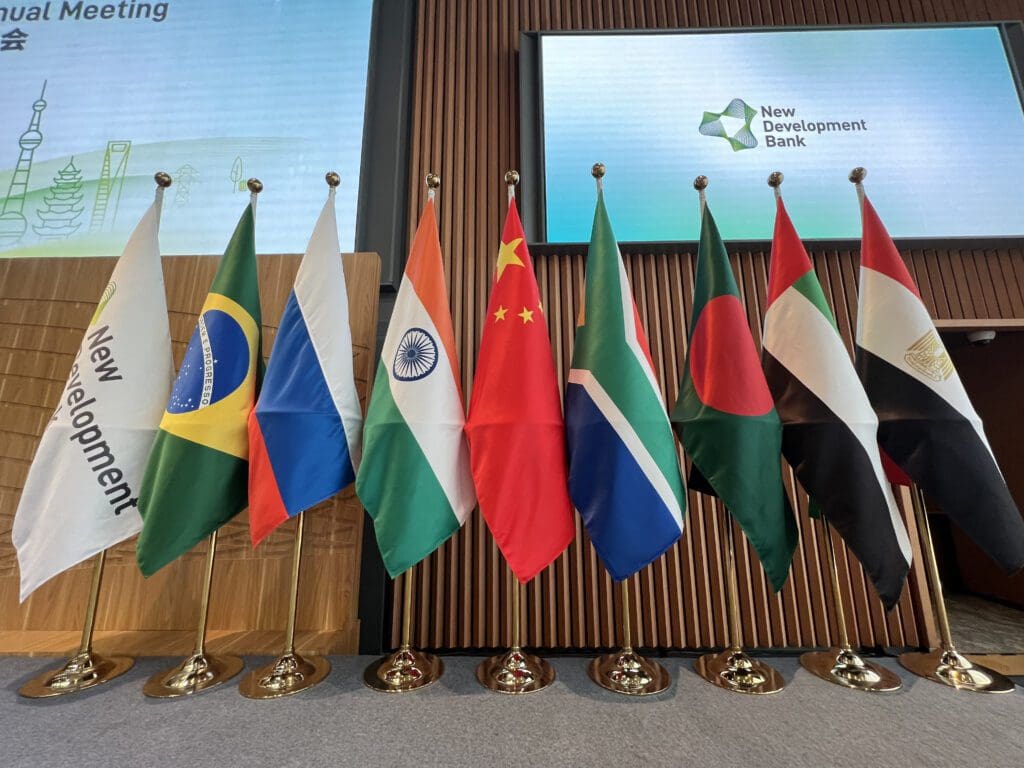At the start of this year, the so-called BRICS group of economies, namely Brazil, Russia, India, China, and South Africa, expanded its membership to five new countries, four of which are from the Middle East and North Africa region. As a global and heterodox bloc comprised of what were once termed “developing nations,” the expanded collective holds tremendous economic clout and, in principle, could exert significant influence over how global development is conducted in the future. But will they do so?
After the inclusion of Saudi Arabia, the United Arab Emirates, Iran, and Egypt—as well as Ethiopia—BRICS now comprises 28 percent of the world’s economy with a total GDP of $28.6 trillion, along with 45 percent of its population. Notably, the new members could play an important role in the work of two BRICS institutions established in 2015—the New Development Bank (NDB) and Contingent Reserve Agreement (CRA)—which are intended to provide alternatives to Western multilateral institutions like the World Bank (IBRD) and International Monetary Fund (IMF). When they were created, their proponents heralded the dawn of a new era in development. Some viewed it as a moment of liberation, in which developing countries would no longer remain under the thumb of former colonial powers or Western political and economic interests. Others saw it as a helpful effort to rebalance the governance of international financial institutions, whose structures had failed to keep pace with the expansion of the global south.
The NDB would be smaller and nimbler, so the argument went, as well as more responsive to its members. As such, it claimed a unique status for itself as an institution “created by economically more developed countries for economically more developed countries.” The reality so far has been underwhelming. The NDB has lent $32 billion for 96 projects from its creation to the present, whereas the World Bank loaned over three times that amount in 2021 alone.
The CRA has yet to be used and was barely mentioned in the communique from the BRICS’ Johannesburg summit in August 2023. Yet the promise of new members, including cash flush nations such as Saudi Arabia and the UAE, has enhanced the prospect that the NDB and CRA may eventually raise their game and become more significant players in global development.
Whether this will actually happen relies upon two important and interrelated questions: what will these entities do, and how will they do it? Regarding the “what” or substantive question, the NDB’s portfolio is unremarkable. Its focus upon six areas under the broader rubric of infrastructure and sustainable development—clean energy and energy efficiency, transport infrastructure, water and sanitation, environmental protection, social infrastructure and digital infrastructure—is helpful but also common among Multilateral Development Banks (MDBs). Indeed, many MDBs are already active in this space, bringing significantly more experience, expertise, and capital to bear—at least for now.
For example, between 2016 and 2021, a World Bank program known as the Digital Development Partnership leveraged $10.7 billion in lending towards information technologies in over 80 countries. The World Bank has focused upon a host of digital services and applications, such as expanding mobile broadband internet, migrating government systems to the cloud, cybersecurity, and a broad spectrum of sector specific applications in areas ranging from health to education to urban transport. The NDB loaned $300 million for one project during this period, a non-sovereign loan to support the expansion of cellular network and cloud services in Russia.
BRICS countries such as China, India and Russia have world-class expertise in digital development, and one would expect their engagement to grow in this area. Yet it is hard to see the NDB as being more than a niche player in many of its chosen sectors over the next decade or more, picking up projects that other donors have elected to pass on or are prohibited from supporting due to safeguards or other reasons. Established institutions have a larger global footprint and an inherent advantage in being able to accumulate and disseminate knowledge across a much broader range of countries, economic systems, and administrative traditions.
The one potential exception is funding for climate change—an area where the needs are vast and current donor contributions are woefully inadequate. Estimates of the additional resources required to support the transition away from fossil fuels to green energy and to make infrastructure more climate-resilient range between $2.7 and $4.5 trillion annually, whereas donors are currently struggling to meet their COP15 goal of mobilizing $100 billion per year. A variety of creative financing solutions are required, including the mobilization of resources from non-traditional sources, and the NDB can make a welcome and badly needed contribution in this area.
Beyond the “what” question, the “how” question of whether the new BRICS members will enhance the bloc’s development work is in many respects more interesting. The NDB’s focus on raising capital in local markets, bringing in private sector participation, and the use of country systems—if successful—could provide valuable lessons for other MDBs. The NDB could leverage additional resources for development that would otherwise go untapped and help fill the large gap in climate-related funding outlined above.
The professed goal of many donor organizations has long been to use a recipient country’s own system of laws, regulations, and procedures for procurement and financial management in order to ease the burden on recipients, yet progress on this front has often remained elusive. If the BRICS are successful, it could provide lessons for other contexts and build momentum for a country systems-centric approach more broadly.
To become the operational exemplar that it aspires to be, the NDB has work to do. Various voices have noted that the new bank needs to pay greater attention to the safeguards it puts in place to regulate social and environmental impact, as well as improve transparency in its operations.
Ultimately, the NDB and CRA are likely to fall short of the extravagant hopes and aspirations of their proponents. They will not fundamentally reorient the way in which development lending occurs, let alone supplant traditional actors such as the World Bank and the IMF. Yet they could play an important role in mitigating the dangers of climate change and in simplifying the oversight and management of development projects through the use of country systems. And that may over time prove to be a more valuable and enduring contribution.


